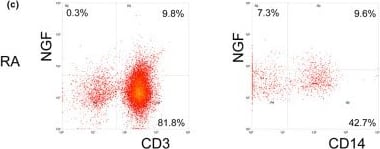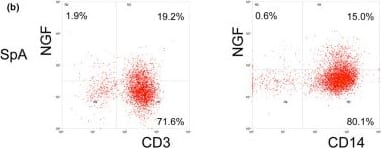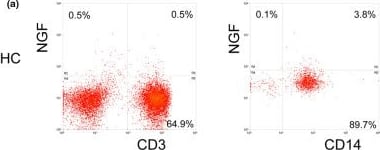 全部商品分类
全部商品分类



 下载产品说明书
下载产品说明书 下载SDS
下载SDS 用小程序,查商品更便捷
用小程序,查商品更便捷


 收藏
收藏
 对比
对比 咨询
咨询ELISA Capture (Matched Antibody Pair)(2-8 µg/mL )
ELISA Detection (Matched Antibody Pair)(0.1-0.4 µg/mL )
ELISA Standard ( )



Ser122-Ala239
Accession # CAA36832

Scientific Data
 View Larger
View LargerDetection of Human beta-NGF by Flow Cytometry NGF staining by flow cytometry. PBMC of (a) healthy controls (HC) and (b) synovial fluid mononuclear cells (SFMC) from spondyloarthritis (SpA), and (c) rheumatoid arthritis (RA) patients were first stained with surface markers (CD3 and CD14) and permeabilized in order to enable intracellular detection of nerve growth factor (NGF). The cells were analysed by flow cytometry after setting lymphocyte (left column) and monocyte (right column) gates according to forward scatter vs side scatter properties of the cells. Dot plots of one representative individual of each group are shown. Image collected and cropped by CiteAb from the following publication (https://arthritis-research.biomedcentral.com/articles/10.1186/ar2716), licensed under a CC-BY license. Not internally tested by R&D Systems.
 View Larger
View LargerDetection of Human beta-NGF by Flow Cytometry NGF staining by flow cytometry. PBMC of (a) healthy controls (HC) and (b) synovial fluid mononuclear cells (SFMC) from spondyloarthritis (SpA), and (c) rheumatoid arthritis (RA) patients were first stained with surface markers (CD3 and CD14) and permeabilized in order to enable intracellular detection of nerve growth factor (NGF). The cells were analysed by flow cytometry after setting lymphocyte (left column) and monocyte (right column) gates according to forward scatter vs side scatter properties of the cells. Dot plots of one representative individual of each group are shown. Image collected and cropped by CiteAb from the following publication (https://arthritis-research.biomedcentral.com/articles/10.1186/ar2716), licensed under a CC-BY license. Not internally tested by R&D Systems.
 View Larger
View LargerDetection of Human beta-NGF by Flow Cytometry NGF staining by flow cytometry. PBMC of (a) healthy controls (HC) and (b) synovial fluid mononuclear cells (SFMC) from spondyloarthritis (SpA), and (c) rheumatoid arthritis (RA) patients were first stained with surface markers (CD3 and CD14) and permeabilized in order to enable intracellular detection of nerve growth factor (NGF). The cells were analysed by flow cytometry after setting lymphocyte (left column) and monocyte (right column) gates according to forward scatter vs side scatter properties of the cells. Dot plots of one representative individual of each group are shown. Image collected and cropped by CiteAb from the following publication (https://arthritis-research.biomedcentral.com/articles/10.1186/ar2716), licensed under a CC-BY license. Not internally tested by R&D Systems.
Human beta -NGF Biotinylated Antibody Summary
Ser122-Ala241
Accession # CAA36832
Applications
Human beta -NGF Sandwich Immunoassay
Please Note: Optimal dilutions should be determined by each laboratory for each application. General Protocols are available in the Technical Information section on our website.
ELISA Capture (Matched Antibody Pair)(2-8 µg/mL )
ELISA Detection (Matched Antibody Pair)(0.1-0.4 µg/mL )
ELISA Standard ( )


Background: beta-NGF
NGF was initially isolated in the mouse submandibular gland as a 7S complex composed of three non-covalently linked subunits, alpha, beta, and gamma. Both the alpha and gamma subunits of NGF are members of the kallikrein family of serine proteases while the beta subunit, called beta -NGF or 2.5S NGF, exhibits all the biological activities ascribed to NGF. Recombinant human beta -NGF is a homodimer of two 120 amino acid polypeptides. The human protein shares approximately 90% homology at the amino acid level with both the mouse and rat beta -NGF and exhibits cross-species activity.
NGF is a well-characterized neurotropic protein that plays a critical role in the development of sympathetic and some sensory neurons in the peripheral nervous system. In addition, NGF can also act in the central nervous system as a trophic factor for basal forebrain cholinergic neurons. NGF has also been shown to have biological effects on non-neuronal tissues. NGF is mitogenic for a factor-dependent human erythroleukemic cell line, TF-1. NGF has been found to increase the number of mast cells in neonatal rats and to induce histamine release from peritoneal mast cells. NGF will enhance histamine release and strongly modulate the formation of lipid mediators by basophils in response to various stimuli. NGF will also induce the growth and differentiation of human B lymphocytes as well as suppress apoptosis of murine peritoneal neutrophils. These results, taken together, suggest that NGF is a pleiotropic cytokine which, in addition to its neurotropic activities, may have an important role in the regulation of the immune system.


Preparation and Storage
- 12 months from date of receipt, -20 to -70 °C as supplied.
- 1 month, 2 to 8 °C under sterile conditions after reconstitution.
- 6 months, -20 to -70 °C under sterile conditions after reconstitution.




